Musée national des beaux-arts du Québec
The Musée national des beaux-arts du Québec (English: National Museum of Fine Arts of Quebec), often abbreviated as MNBAQ, is an art museum in Quebec City, Quebec, Canada. The museum is situated in Battlefield Park, and is a complex made up of four buildings. Three of the buildings in the complex were purpose-built for the museum, while the other was initially built as a provincial prison, before being re-purposed for museum use.
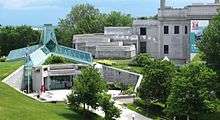 The Central Pavilion with Gérard-Morisset Pavilon in the background | |
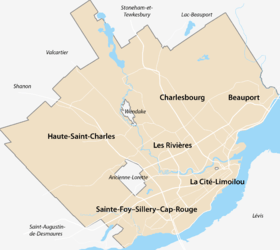 Location of Musée national des beaux-arts du Québec in Quebec City | |
| Former name |
|
|---|---|
| Established | 5 June 1933 |
| Location | The Battlefields Park, Quebec City, Quebec, Canada |
| Coordinates | 46°47′56″N 71°13′29″W |
| Type | Art museum |
| Visitors | 387,333 (2017-18)[1] |
| Director | Jean-Luc Murray[2] |
| President | Christiane Germain[3] |
| Owner | Government of Quebec |
| Website | www |
The institution was opened as the Musée de la province de Québec in 1933. The museum initially served as the provincial archives, art, and natural science museum until 1962, when the natural science collection was removed. In the following year, the museum was renamed the Musée du Quebec. The provincial archives were moved from the museum in 1979, leaving it solely as an art museum. In 2002, the museum was renamed the Musée national des beaux-arts du Québec.
Its collection includes over 40,000 works spanning from the 16th century, to the present day. Its collection primarily includes works that were produced in Quebec, or by Quebec artist, although it does also includes works from other parts of Canada, and the rest of the world. The museum is affiliated with the Canadian Museums Association, the Canadian Heritage Information Network, and the Virtual Museum of Canada.
History
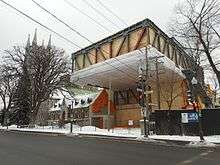
Prior to the formal establishment of the museum, several items for the museum's art, and natural history collections were acquired for the museum prior to the institution's creation.[4] The Premier of Quebec Lomer Gouin first presented the idea of starting a provincial collection of art as a part of a program to "define the Quebec nation," although most of the actual program was organized under his successor, Louis-Alexandre Taschereau.[4] The program formally began in March 1920, when the cabinet minister, Athanase David, announced an initiative that saw the province support artists by buying their works.[4] Works initially acquired for this collection were selected by a five-man jury, who sought to affirm "innovative art trends," found among artists in Quebec, as well as works that push the conception of a common rural past.[5]
In 1922, the legislature of Quebec passed the Loi des musées de la province du Québec (English: Act Respecting Museums in the Province of Quebec), providing funding for the construction of museums throughout the province.[6] However construction for the Gérard-Morisset Pavilion did not begin until 1928; with the museum finally opened to the public in June 1933.[7] Initially the museum operated as an art museum, a natural science museum, and as the provincial archives.[8][9]
The natural history collection was removed from the museum in 1962, and the institution was renamed Musée du Québec the following year.[8][9] The provincial archives was moved from the museum to the Université Laval in 1979, leaving the institution with only its art collection.[8][9] The institution was formally made into a provincial Crown corporation in 1983.[8][9]
From 1989 to 1991, the museum renovated and incorporating a former prison, Charles Baillairgé Pavilion, into its building complex.[8][9] The acquisition and renovation of the former prison building had more than doubled the surface space the museum had.[8] The renovation of the former prison expanded the museum's viewing space to 12 galleries, as well as provided space for an auditorium, a giftshop, restaurant, storerooms, and a workshops.[8] The museum's sculpture garden was completed shortly after the Charles Baillairginé Pavilion opened in 1993.[9]
In 2002, the museum was renamed the Musée national des beaux-arts du Québec.[8][9] In 2013, the museum began work on a new pavilion, the Pierre Lassonde Pavilion, and was opened in 2016.[9]
Architecture
The property is situated in Battlefield Park, with the museum complex made up of four buildings, the Gérard-Morisset Pavilion, the Charles Baillairgé Pavilion, the Pierre Lassonde Pavilion, and the Central Pavilion/Grand Hall. The pavilions are connected to one another through a tunnel network.
Gérard-Morisset Pavilion
The Gérard-Morisset Pavilion was the first building built for the museum. Work on the building began in May 1928, and was completed in early 1931.[7] The building was designed in a Beaux-Arts style by Wilfrid Lacroix; while the reliefs on the facade were sculpted by Joseph-Émile Brunet.[10] The building was opened to the public in June 1933.[9] The building features white marble, wide Victorian style steps, carved ceilings.[11] In 2018, the museum completed renovations of the Gérard-Morisset Pavilion, which saw the brightening of its viewing spaces, as well as harmonizing the structure with the rest of the museum complex.[12]
Charles Baillairgé Pavilion
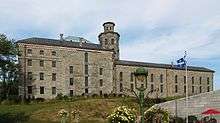
The Charles Baillairgé Pavilion is the second building that the museum occupied, although its age predates the other buildings in the museum complex.[10] The pavilion was designed by Charles Baillairgé in 1867, and was initially used as a prison.[10] The design was modelled after the Auburn Correctional Facility, in Auburn, New York.[11] The building was used to house inmates until 1970.[11]
Shortly after acquiring the property, the museum underwent a two-year renovation beginning in 1989.[10] The renovations led to the creation of four exhibition galleries within the pavilion,[10] as well as a section of preserved jail cells to highlight the building's former use as a prison.[8] Designs for the renovation were by Charles Dorval and Louis Fortin.[8] Along with the building, Dorval and Fortin also designed the underground access that connected Gérard Morisset pavilion with the Charles Baillairgé pavilion.[8] In an effort to maintain the Battlefield Park, the design concealed a section of the new wing under the park's natural landscaping.[8] The museum opened the pavilion to the public in May 1991.[7]
Central Pavilion
The glass-facade pyramid, known as the Central Pavilion or Grand Hall was built during the 1989–1991 renovations of the museum complex, and was also designed by Dorval and Fortin.[8][10] The Central Pavilion lies in between the Gérard-Morisset Pavilion with the Charles Baillairgé Pavilion, and serves as the museum's visitor centre.[10]
Pierre Lassonde Pavilion
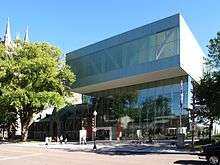
Construction of the Pierre Lassonde Pavilion began in 2013, and was opened in June 2016.[8] The pavilion provides a glass-enclosed access from Grande Allée to the rest of the museum complex, situated further within Battlefield Park.[13] The 14,900 square metres (160,000 sq ft) pavilion was designed by the Office for Metropolitan Architecture, led by Jason Long, and Shohei Shigematsu, the lead partners for the design project.[14][15]During the construction of the building, renovations were also undertaken to the museum's tunnel system, transforming them into viewing spaces.[13] The building is adjacent to Saint-Dominique Church, and has a tunnel that provides indoor connection to the other pavilions of the museum complex.[13] The pavilion largely uses glass and steel for its building material, in an effort to foster transparency between the museum, and the general public.[13]
The total cost for the construction of the pavilion was approximately C$103.4 million.[13] The pavilion features 2,741 square metres (29,500 sq ft) of gallery space;[14] and also includes a cafe in its main lobby, a courtyard adjacent to the lobby, a white spiral staircase, and a gold-coloured elevator.[13] The building was named after Pierre Lassonde, a benefactor of the museum.[13] The colouring of the gold elevator was chosen to reflect Lassonde's work with gold.[13]
Permanent collection
As of March 2019, the museum's permanent collection includes 40,000 works from 4,524 different artists from Quebec, the rest of Canada, and around the world from the 16th century to present day.[16][1] The legislative act that governs the institutions notes that the museum's purpose is to promote, and preserve art from Quebec, from all periods in history, as well as presence for international art.[17] The museum's permanent collection was either acquired through donations, purchase, or ordered directly from the artist/collector/merchant.[18] The first works acquired for the collection was from the Art Association of Montreal's 37th Spring Exhibition in 1920, although only six works acquired during that time remains in the museum's permanent collection.[19]
Each pavilion in the museum complex houses a different department of the museum's collection. Gérard-Morisset Pavilion houses the museum's historical art collection; the Charles Baillairgé Pavilion houses works of modern art, while the Pierre Lassonde Pavilion houses works of contemporary art.[11][13][20]
Selected works
.jpg) Unknown, Gaspard-Joseph Chaussegros de Léry, c. 1718.
Unknown, Gaspard-Joseph Chaussegros de Léry, c. 1718. Jean-Jacques Lagrenée, La Mise au tombeau, 1770.
Jean-Jacques Lagrenée, La Mise au tombeau, 1770. François Beaucourt, Madame Eustache Trottier Desrivières Beaubien, née Marguerite Malhiot, 1793.
François Beaucourt, Madame Eustache Trottier Desrivières Beaubien, née Marguerite Malhiot, 1793. James Pattison Cockburn, The Ice Cone at Montmorency Falls. c. 1830.
James Pattison Cockburn, The Ice Cone at Montmorency Falls. c. 1830.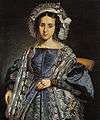 Antoine Plamondon, Madame Joseph Laurin, née Marie-Louise Dalaire, 1839.
Antoine Plamondon, Madame Joseph Laurin, née Marie-Louise Dalaire, 1839.- Edwin Whitefield, Montréal vu du mont Royal, 1853–54.
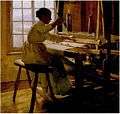 William Brymner, Woman at Work, 1885.
William Brymner, Woman at Work, 1885.
 Charles Huot, La Traversée du fleuve en hiver, c. 1902.
Charles Huot, La Traversée du fleuve en hiver, c. 1902. Henri Beau, L'arrivée de Champlain à Québec, 1903.
Henri Beau, L'arrivée de Champlain à Québec, 1903..jpg) Henri Julien, La Chasse-galerie, 1906.
Henri Julien, La Chasse-galerie, 1906. Marc-Aurèle de Foy Suzor-Coté, Jacques Cartier rencontre les Indiens à Stadaconé, 1535, 1907.
Marc-Aurèle de Foy Suzor-Coté, Jacques Cartier rencontre les Indiens à Stadaconé, 1535, 1907. Helen McNicoll, In the Shadow of the Tree, c. 1910.
Helen McNicoll, In the Shadow of the Tree, c. 1910. Alfred Laliberté, Le Fardeau, c. 1925.
Alfred Laliberté, Le Fardeau, c. 1925. Maurice Cullen, La Fonte des neiges, 1930.
Maurice Cullen, La Fonte des neiges, 1930. Unknown, La Construction de la porte Saint-Jean, Québec, c. 1938–39.
Unknown, La Construction de la porte Saint-Jean, Québec, c. 1938–39. Armand Vaillancourt, L'Arbre de la rue Durocher, 1953–56.
Armand Vaillancourt, L'Arbre de la rue Durocher, 1953–56. Étienne Martin, Demeure III, 1960.
Étienne Martin, Demeure III, 1960. Charles Daudelin, La Cavalière, 1963.
Charles Daudelin, La Cavalière, 1963. Jean-Paul Riopelle, La Victoire et le Sphinx, 1963–65.
Jean-Paul Riopelle, La Victoire et le Sphinx, 1963–65.- Claude Tousignant, Accélérateur chromatique 1967, de l'album, 1971.
 Michel Goulet, Assemblée, 1987.
Michel Goulet, Assemblée, 1987. Bill Vazan, Event Horizon, 1989–91.
Bill Vazan, Event Horizon, 1989–91. Bernar Venet, Deux Arcs de 245,5°, 1997.
Bernar Venet, Deux Arcs de 245,5°, 1997.
Library and archives
The museum also operates a library and archives that specializes in Quebec art.[21] The library over 13,000 biographical files, in addition to catalogs, monographs, and audiovisual documents relating to art in Canada, and around the world.[21] Access to the museums library and archives requires a scheduled appointment made with the museum. Fonds that have been computerized may be accessed from CUBIQ, the central catalogue for publicly operated libraries in Quebec.[21]
References
- "Musée national des beaux-arts du Québec: Rapport annuel 2018 -2019" (in French). Musée national des beaux-arts du Québec. 31 March 2019. pp. 11–12. Retrieved 29 October 2019.
- "Le conseil d'administration du MNBAQ annonce la nomination de Jean-Luc Murray à la direction générale". newswire.ca. CNW Group Ltd. 7 November 2018. Retrieved 3 February 2019.
- "Board of Directors". mnbaq.org. Musée national des beaux-arts. 2019. Retrieved 3 February 2019.
- Lacroix 2008, p. 127.
- Lacroix 2008, p. 149.
- Fougères, Dany; MacLeod, Roderick (2018). Montreal: The History of a North American City. 1. McGill-Queen's University Press. p. 552. ISBN 0-7735-5128-X.
- Landry, Pierre B. (2009). 75 ans chrono: le Musée national des beaux-arts du Québec, 1933-2008 (in French). Musée national des beaux-arts du Québec. ISBN 2-5512-3759-9.
- Champagne, Michel; Baird, Daniel; McIntosh, Andrew (30 April 2019). "Musée national des beaux-arts du Québec". The Canadian Encyclopedia. Historica Canada. Retrieved 28 October 2019.
- "History". mnbaq.org. Musée national des beaux-arts. 2019. Retrieved 28 October 2019.
- Carr, Angela (4 March 2015). "Architecture of Art Galleries in Canada". The Canadian Encyclopedia. Historica Canada. Retrieved 28 October 2019.
- Bennett, Andrea (2019). Moon Québec City. Avalon Publishing. ISBN 1-6404-9333-6.
- "Réouverture du pavillon Gérard-Morisset du Musée national des beaux-arts du Québec". Le journal de Quebec (in French). QMI Media Inc. 16 November 2018. Retrieved 28 October 2019.
- Plante, Caroline (22 June 2016). "Quebec City's fine arts museum opens new $100 million wing". Montreal Gazette. Postmedia Network Inc. Retrieved 29 October 2019.
- "Pierre Lassonde Pavilion". oma.eu. Office of Metropolitan Architecture. Retrieved 10 March 2020.
- "OMA's Shohei Shigematsu designs the Pierre Lassonde Pavilion". Archpaper.com. 2016-08-15. Retrieved 2020-03-10.
- "Collections". mnbaq.org (in French). Musée national des beaux-arts du Québec. 2019. Retrieved 29 October 2019.
- "Loi sur les Musée nationaux". legisquebec.gouv.qc.ca (in French). Gouverment du Quebec. 1 September 2019. Retrieved 29 September 2019.
- Lacroix 2008, p. 123.
- Lacroix 2008, p. 148.
- "Plan du Musée". mnbaq.org (in French). Musée national des beaux-arts du Québec. 2019. Retrieved 29 October 2019.
- "Bibliothèque, Archives, et Collections". mnbaq.org. Musée national des beaux-arts du Québec. Retrieved 1 December 2019.
Further reading
- Lacroix, Laurier (2008). "La collection comme temps de la Nation: Les premières acquisitions du Musée de la province de Québec en 1920". Les Cahiers des dix (in French). 62: 123–151.CS1 maint: ref=harv (link)
External links
| Wikimedia Commons has media related to Musée national des beaux-arts du Québec. |